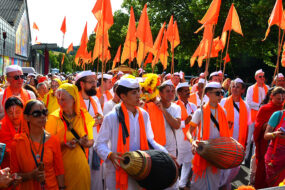- Home
- Culture & Community
- Heritage
- “Nalanda was the Harvard, Ox ...
Nalanda University: A Symbol of India’s Ancient Wisdom
A Journey into the Heart of Ancient Learning
Imagine walking through a vast stone complex under the golden sun of 7th century India. Monks in deep saffron robes walk by, manuscripts in hand, discussing the nature of the universe in Sanskrit, Pali, and Tibetan. The air is filled with quiet determination and deep reverence for knowledge. This was Nalanda — a thriving ecosystem of learning, centuries ahead of its time.
A Civilizational Marvel
Founded in the 5th century CE during the reign of Kumaragupta I of the Gupta Empire, Nalanda wasn’t just another center of education. It was the world’s first residential international university, flourishing for over 700 years. Situated in modern-day Bihar, it hosted more than 10,000 students and 2,000 teachers, becoming a magnet for scholars from China, Tibet, Korea, Mongolia, Japan, and Sri Lanka.
Its curriculum was vast and rigorous. Nalanda offered studies in:
Buddhist Philosophy and Logic
Mathematics and Astronomy
Medicine and Health Sciences
Grammar, Literature, and Languages
Fine Arts and Architecture
This diversity made it not just a Buddhist monastery, but a global academic powerhouse. Scholars engaged in logic-based debates, intellectual discourses, and empirical observations—setting a standard that would resonate across continents.
The Mountain of Truth
One of Nalanda’s most legendary features was its library complex called Dharma Gunj or “Mountain of Truth.” It reportedly housed millions of manuscripts across three majestic buildings:
Ratnasagara (Ocean of Jewels) — sacred scriptures
Ratnadadhi (Sea of Jewels) — texts on science, astronomy, and medicine
Ratnaranjaka (Jewel-Adorned) — literature and art
Chinese monk Xuanzang, who studied here in the 7th century, described the library as so vast that it took months to read through a single section. When invaders later set fire to it, records say the library burned for months due to the sheer volume of texts.
Where the World Came to Learn
Xuanzang (Hiuen Tsang) was one among many international scholars who came to Nalanda. His accounts highlight the university’s rigorous admission process — only students capable of intense debate and spiritual discipline were allowed entry. Teachers such as Dharmapala, Silabhadra, and Nagarjuna led structured, philosophical dialogues that shaped Buddhist and secular thought alike.
A Tragic End
Nalanda’s golden age ended in 1193 CE when it was destroyed by Bakhtiyar Khilji, a Turkic invader. The once vibrant center of thought was reduced to ashes, and its scholars were scattered. Yet the spirit of Nalanda lived on — carried by monks, documented by travelers, and honored in memory.
Rebirth of a Legend
Centuries later, the idea of Nalanda refused to fade. In 2010, the Government of India, with support from 17 nations, initiated the Nalanda University revival project. Built near its original site in Rajgir, Bihar, the university now focuses on:
Buddhist Studies, Philosophy & Comparative Religion
Sustainable Development & Ecology
Historical & Global Interconnectivity
Today, students from India, Germany, Bhutan, Laos, and many other countries are once again gathering to learn, debate, and create knowledge that bridges cultures.
Nalanda & Indo-German Academic Exchange
Nalanda’s original global character finds resonance today in its partnership with countries like Germany. Through the Indo-German Science and Technology Centre (IGSTC) and institutions like DAAD (German Academic Exchange Service), scholars collaborate on:
Climate ethics and sustainability
Comparative religion and Buddhist philosophy
Environmental humanities and cultural diplomacy
This Indo-German partnership honors Nalanda’s legacy as a global crossroads of ideas, marrying Indian traditional knowledge with German scientific rigor.
Recent Research and Discoveries
Modern research has expanded our understanding of Nalanda’s vast influence. Key sources include:
“The Art and Architecture of Ancient Nalanda” by ASI: This study maps architectural advances that mirror Buddhist iconography and regional design styles.
“Xuanzang’s Nalanda Memoirs” (translated by Samuel Beal): Offers firsthand insight into daily academic life, administration, and scholarly debates.
“Reviving Nalanda: Memory, History and the Contemporary” by Amrita Singh: Explores the philosophical and political significance of Nalanda’s revival in modern times.
Publications by Nalanda University Press: Cover research in sustainable development, interfaith dialogue, and ecological ethics, including Indo-German comparative studies.
These references help bridge ancient insights with today’s academic frameworks.
A Legacy That Shapes the Future
So, why does Nalanda matter today?
Preserves Ancient Knowledge: From astronomy to ethics, Nalanda’s teachings laid intellectual foundations still relevant today.
Promotes Cross-Cultural Learning: A living example of how East met East — and now, East meets West.
Models Holistic Education: Mind, body, spirit — all nurtured equally.
Represents Resilience: Destroyed, but never forgotten. Rebuilt with a vision for global impact.
UNESCO World Heritage Site
In 2016, the ruins of Nalanda Mahavihara were recognized by UNESCO as a World Heritage Site, affirming its unparalleled role in shaping human history. The site remains a symbol of India’s intellectual contributions to global civilization.
Explore more:
Curious to learn more? Here are official sources where you can explore Nalanda’s rich history and its modern impact:
Nalanda University Official Site: www.nalandauniv.edu.in
UNESCO World Heritage Listing: whc.unesco.org




